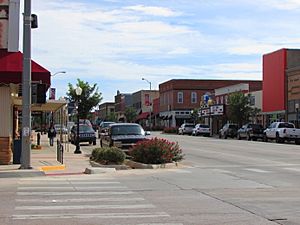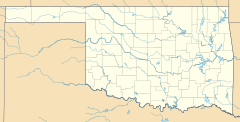Kingfisher, Oklahoma facts for kids
Quick facts for kids
Kingfisher, Oklahoma
|
|
|---|---|
 |
|
| Country | United States |
| State | Oklahoma |
| County | Kingfisher |
| Area | |
| • Total | 4.52 sq mi (11.71 km2) |
| • Land | 4.46 sq mi (11.56 km2) |
| • Water | 0.06 sq mi (0.15 km2) |
| Elevation | 1,089 ft (332 m) |
| Population
(2020)
|
|
| • Total | 4,903 |
| • Density | 1,098.59/sq mi (424.12/km2) |
| Time zone | UTC-6 (Central (CST)) |
| • Summer (DST) | UTC-5 (CDT) |
| ZIP code |
73750
|
| Area code(s) | 405/572 |
| FIPS code | 40-39850 |
| GNIS feature ID | 2411546 |
Kingfisher is a city in Oklahoma, and it is the main town of Kingfisher County. In 2020, about 4,903 people lived there. It used to be home to Kingfisher College, which was named after the town. Today, many people who live in Kingfisher travel to work in nearby cities like Enid and Oklahoma City.
Contents
History of Kingfisher
The Early Days: 1800s
Kingfisher started on April 22, 1889, during a "land run". This was when the government opened up a huge area of land in central Oklahoma for people to settle. Many non-Native Americans moved into the area very quickly.
The city is located on a part of the Chisholm Trail. This was a famous path where millions of Texas longhorn cattle were moved from Texas to train stations in Kansas after the Civil War. This way of life changed when railroads were built and more land was settled.
The town was named after an early resident called King Fisher, who also had other places named after him.
A law that opened up Oklahoma Territory said that towns could only be a certain size. Because of this, settlers in the Kingfisher area first formed two small towns: Kingfisher City to the north and Lisbon to the south. These two towns joined together on June 14, 1890, and the combined town was named Kingfisher.
Oklahoma Territory was officially created on May 2, 1890. Abraham Jefferson Seay, who was from Missouri, became a judge in the area and moved to Kingfisher. In 1892, President Benjamin Harrison chose Seay to be the second governor of the territory.
Railroads were very important for Kingfisher's growth. The Chicago, Kansas and Nebraska Railway (which later became part of the Rock Island) built tracks through the area. The first passenger train arrived on October 23, 1889.
A newspaper was printed in Kingfisher for many years, from 1889 to 1963. It had different names over time, like Kingfisher Free Press and Kingfisher Weekly Star and Free Press.
The 1900s and Beyond
The Coleman Company, which makes outdoor gear, was started in Kingfisher by W. C. Coleman in 1900.
In 1900, more railroads were built. The Guthrie and Kingfisher Railway connected Kingfisher to the east, and the Guthrie and Western Railway connected it to the west. This gave Kingfisher access to the territorial capital, Guthrie, and the Santa Fe train system. Some of these train lines were closed in the 1930s, but Kingfisher still has freight train service today on what is now the Union Pacific Railroad.
In 1958, the Kingfisher County Development Foundation was created. Its goal is to help the area grow in terms of businesses, economy, and community life. One of their projects is the Kingfisher Industrial Park, located south of the city. This park helps bring more jobs and development to the area. Kingfisher has become a suburban community for the Oklahoma City area, meaning many people live in Kingfisher and travel to Oklahoma City for work.
In 2007, on August 19, about 25% of the city was flooded. This happened when Kingfisher Creek and Uncle John Creek overflowed because of heavy rain from Tropical Depression Erin. Sadly, one person died in the flood.
Geography and Climate
Where is Kingfisher?
Kingfisher is located in the south-central part of Kingfisher County. It is about 42 miles (68 km) northwest of Oklahoma City. U.S. Route 81 (Main Street) goes through the middle of town. This road leads north to Enid and south to El Reno. Oklahoma State Highway 3 (Broadway Avenue) crosses US 81 in the center of town. This highway goes east to Guthrie and west to Watonga.
The United States Census Bureau says that Kingfisher covers a total area of about 4.52 square miles (11.71 km²). A small part of this, about 0.06 square miles (0.15 km²), is water. Kingfisher Creek flows through the city and eventually joins the Cimarron River.
Kingfisher's Weather
Kingfisher has a climate with hot summers and mild winters. The hottest temperature ever recorded was 118°F (48°C) in August, and the coldest was -20°F (-29°C) in February. The city gets about 33 inches (84 cm) of rain each year.
| Climate data for Kingfisher, Oklahoma | |||||||||||||
|---|---|---|---|---|---|---|---|---|---|---|---|---|---|
| Month | Jan | Feb | Mar | Apr | May | Jun | Jul | Aug | Sep | Oct | Nov | Dec | Year |
| Record high °F (°C) | 85 (29) |
93 (34) |
100 (38) |
103 (39) |
105 (41) |
113 (45) |
115 (46) |
118 (48) |
110 (43) |
101 (38) |
90 (32) |
88 (31) |
118 (48) |
| Mean daily maximum °F (°C) | 47.4 (8.6) |
53.8 (12.1) |
63.3 (17.4) |
72.4 (22.4) |
80.5 (26.9) |
89.5 (31.9) |
95.2 (35.1) |
94.3 (34.6) |
85.8 (29.9) |
74.9 (23.8) |
60.0 (15.6) |
49.9 (9.9) |
72.4 (22.4) |
| Mean daily minimum °F (°C) | 24.5 (−4.2) |
29.4 (−1.4) |
37.8 (3.2) |
46.7 (8.2) |
56.7 (13.7) |
65.8 (18.8) |
70.5 (21.4) |
69.2 (20.7) |
61.4 (16.3) |
49.7 (9.8) |
37.1 (2.8) |
27.8 (−2.3) |
48.2 (9.0) |
| Record low °F (°C) | −16 (−27) |
−20 (−29) |
−3 (−19) |
15 (−9) |
28 (−2) |
45 (7) |
51 (11) |
44 (7) |
29 (−2) |
12 (−11) |
6 (−14) |
−14 (−26) |
−20 (−29) |
| Average precipitation inches (mm) | 1.14 (29) |
1.51 (38) |
2.66 (68) |
3.23 (82) |
5.01 (127) |
4.32 (110) |
2.22 (56) |
2.75 (70) |
3.53 (90) |
2.57 (65) |
2.38 (60) |
1.63 (41) |
32.95 (837) |
| Average snowfall inches (cm) | 1.8 (4.6) |
0.7 (1.8) |
0.1 (0.25) |
0 (0) |
0 (0) |
0 (0) |
0 (0) |
0 (0) |
0 (0) |
0 (0) |
0.3 (0.76) |
1.1 (2.8) |
4.1 (10) |
| Average relative humidity (%) | 72 | 70 | 71 | 69 | 73 | 69 | 60 | 60 | 65 | 69 | 73 | 75 | 69 |
| Source: Oklahoma Climatological Survey | |||||||||||||
People of Kingfisher
Population Changes Over Time
The number of people living in Kingfisher has changed over the years. Here's a look at the population from 1890 to 2020:
| Historical population | |||
|---|---|---|---|
| Census | Pop. | %± | |
| 1890 | 1,134 | — | |
| 1900 | 2,301 | 102.9% | |
| 1910 | 2,538 | 10.3% | |
| 1920 | 2,446 | −3.6% | |
| 1930 | 2,726 | 11.4% | |
| 1940 | 3,352 | 23.0% | |
| 1950 | 3,345 | −0.2% | |
| 1960 | 3,249 | −2.9% | |
| 1970 | 4,042 | 24.4% | |
| 1980 | 4,245 | 5.0% | |
| 1990 | 4,095 | −3.5% | |
| 2000 | 4,380 | 7.0% | |
| 2010 | 4,633 | 5.8% | |
| 2020 | 4,903 | 5.8% | |
| U.S. Decennial Census | |||
Who Lives in Kingfisher?
In 2010, there were 4,633 people living in Kingfisher. Most people (83.9%) were White. There were also smaller groups of African American (1.6%), Native American (3.8%), and Asian (0.5%) residents. About 6.9% of the population were from other races, and 3.3% were from two or more races. People of Hispanic or Latino background made up 12.4% of the population.
There were 1,804 households in the city. About 28.4% of these households had children under 18 living with them. Many households (51.5%) were married couples living together. The average household had 2.5 people, and the average family had 3.06 people. The average age of people in Kingfisher was 37 years old. Slightly more than half of the population (52.1%) was female, and 47.9% was male.
In 2013, the average income for a household in Kingfisher was about $49,727 per year. For families, the average income was $59,408. The average income per person in the city was $24,363. A small number of families (7.7%) and people (5.8%) lived below the poverty line.
Places to Visit
Kingfisher has a special place to visit called the Chisholm Trail Museum. This museum also includes the Gov. Seay Mansion. It helps to keep the history of the community alive by showing old items and sharing information about Kingfisher's unique past.
Famous People from Kingfisher
Many notable people have connections to Kingfisher, including:
- George S. Benson – A missionary and college leader.
- Don Blanding – A poet.
- Sol Butler – An early Black Olympian and NFL player in the 1920s.
- Arthur A. Collins – The person who started Collins Radio Company.
- Elmer Crumbley – A jazz trombonist.
- Erna P. Harris – A journalist.
- Curtis Lofton – An NFL linebacker who played for the Oakland Raiders.
- Carl Mays – A MLB pitcher who won the World Series four times.
- Joe Redington – The founder of the Iditarod Sled Dog Race.
- Abraham Jefferson Seay – A judge and the second Governor of Oklahoma Territory.
- Jace Sternberger – An American football player.
- James "Bud" Walton – Co-founder of Wal-Mart.
- Sam Walton – The founder of Wal-Mart and Sam's Club.
See also
 In Spanish: Kingfisher (Oklahoma) para niños
In Spanish: Kingfisher (Oklahoma) para niños



